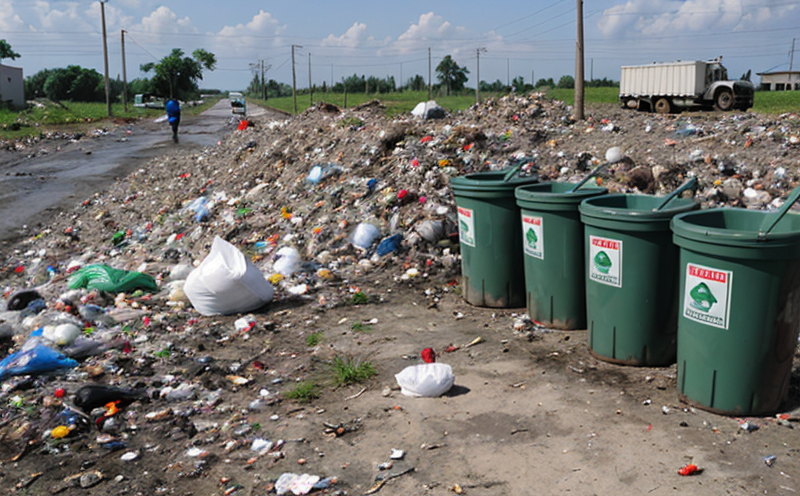ISO 10381-5 Soil and Solid Waste Sampling Techniques Test
The ISO 10381-5 standard is a critical component in ensuring the accurate and reliable sampling of soil and solid waste, which is crucial for environmental testing. This standard provides detailed procedures aimed at minimizing the variability associated with sampling practices. In sectors such as construction, agriculture, and industrial waste management, adherence to these guidelines ensures that data collected can be trusted and used effectively for decision-making processes.
Sampling errors are common in soil and solid waste analysis due to various factors including spatial heterogeneity, temporal variation, and the nature of the material itself. ISO 10381-5 addresses these challenges by offering standardized methods that account for these complexities. The standard outlines specific sampling strategies based on the type of sample (e.g., bulk or point samples) and the intended use of the data.
For instance, when dealing with heterogeneous materials like construction debris or agricultural waste, ISO 10381-5 recommends stratified random sampling to capture representative samples across different layers. This approach is essential for accurate characterization of such complex matrices. Similarly, for homogeneous materials, it suggests systematic sampling techniques that ensure a consistent sample size and distribution.
The standard also emphasizes the importance of proper sampling equipment and procedures to prevent contamination or bias in the results. Properly trained personnel are crucial in executing these methods correctly; thus, compliance with ISO 10381-5 ensures not only accurate data but also reliable and repeatable measurements, which are vital for regulatory compliance.
In summary, adhering to ISO 10381-5 helps stakeholders achieve consistent, high-quality sampling results that are essential for effective environmental management. By reducing variability in the sampling process, this standard supports more informed decision-making processes across various industries dealing with soil and solid waste.
- Reduces variability in sampled data due to standardized methods
- Ensures accurate and reliable characterization of complex matrices
- Supports consistent and repeatable measurements
- Aids in regulatory compliance through standardization
- Promotes efficient use of resources by minimizing waste from improper sampling
- Facilitates better communication between different stakeholders involved in the testing process
Applied Standards
The ISO 10381-5 standard is widely recognized and applied across numerous sectors. It is particularly relevant for industries dealing with construction debris, agricultural waste management, industrial waste treatment, and environmental monitoring. The application of this standard ensures that the sampling practices used are consistent with international best practices.
For instance, in construction projects involving demolition or renovation activities, ISO 10381-5 provides guidelines on how to sample materials like concrete, brick, and other building components to assess their quality and safety. In agricultural settings, it helps in evaluating the impact of waste disposal on soil health and crop yields by providing robust sampling techniques.
Industrial waste management facilities also benefit significantly from following this standard as it ensures that samples taken for compliance testing or research purposes are representative of the entire batch or lot being tested. This consistency is crucial when determining whether a particular material meets environmental regulations or industrial standards.
The standard's scope includes detailed descriptions on selecting sample points, defining the boundaries of sampling zones, and specifying equipment to be used during collection. These provisions ensure that every step involved in the sampling process adheres to recognized protocols, thereby enhancing confidence in the results obtained.
Benefits
- Increased Accuracy: Standardized methods minimize variability and ensure accurate representation of soil or solid waste characteristics.
- Enhanced Reliability: Consistent sampling techniques lead to reliable data that can be trusted for various applications including regulatory compliance.
- Cost Efficiency: Properly executed sampling reduces the likelihood of costly rework due to non-compliant samples or erroneous test results.
- Better Decision Making: Reliable and accurate data supports informed decisions regarding resource allocation, waste management strategies, and environmental policies.
The benefits extend beyond just compliance; they encompass broader improvements in operational efficiency and sustainability. By adhering to ISO 10381-5, organizations can demonstrate their commitment to sustainable practices while also improving internal processes and reducing overall costs associated with improper sampling techniques.
Why Choose This Test
- International Recognition: ISO standards are globally recognized, ensuring that the results obtained from this test will be accepted worldwide.
- Scientific Rigor: The methodologies outlined in ISO 10381-5 are based on scientific principles and have been peer-reviewed to ensure their validity.
- Regulatory Compliance: Adherence to these standards ensures that your organization meets all necessary legal requirements, avoiding potential fines or penalties.
- Expertise: Our laboratory employs trained professionals who are certified in performing these tests according to international guidelines.
Selecting ISO 10381-5 soil and solid waste sampling techniques not only enhances the accuracy of your data but also positions you as a leader in environmental stewardship. This commitment translates into long-term benefits such as improved reputation, enhanced customer satisfaction, and reduced risk exposure.





